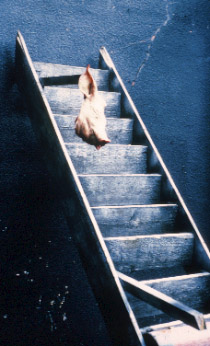THE
BURN
8 hours non-stop performance and installation (actuation)
at Burned Out Project Arts Centre, Dublin, Ireland
Saturday 3rd September 1988 9:05am - 5:05pm
* * *

from High Performance Winter 1988 No 44
by Steven Durland
Belfast artist and teacher Alastair MacLennan is probably Ireland's most well known performance artist (although originally a Scot) and has appeared a number of times in the US. His style of working has been consistent for many years. He creates an environment of elements and then places himself in that environment for extended periods of time. I had seen him do an installation/performance in the US in a gallery, but this was my first experience seeing him in a site-specific location, actually more typical of his recent work.
 The
Burn was an eight-hour piece (a rather short duration for a MacLennan
work) presented in the shell of a roofless, burned-out building adjoining
The Project. The installation could only be approached and viewed through
the space where the building's door had originally been located. The building
floor was covered with brown leaves and littered with what was probably
the remaining detritus of the building: pieces of beam, burned fire extinguishers,
a partial stairway leading to a brick wall, etc. On the ground in front
of the viewer were 18 halved pig's heads, with perhaps another dozen hanging
evenly spaced at eye-level along the side and back walls, bringing to
my mind some sort of demonic art gallery.
The
Burn was an eight-hour piece (a rather short duration for a MacLennan
work) presented in the shell of a roofless, burned-out building adjoining
The Project. The installation could only be approached and viewed through
the space where the building's door had originally been located. The building
floor was covered with brown leaves and littered with what was probably
the remaining detritus of the building: pieces of beam, burned fire extinguishers,
a partial stairway leading to a brick wall, etc. On the ground in front
of the viewer were 18 halved pig's heads, with perhaps another dozen hanging
evenly spaced at eye-level along the side and back walls, bringing to
my mind some sort of demonic art gallery.
I visually searched the area quite intently looking for MacLennan and finally realised he was sitting silently high above the floor straddling a roof beam. Also hanging from the beam were two ropes, dangling the tattered remains of a British and an Irish flag. During the course of the day he moved to various positions on the beam. The weather, alternately overcast and rainy, appropriately completed the stark, post-holocaustal scene.
Even though the flags might indicate that the work was focussed on the war in Northern Ireland, I suspect they stood more for the general horror of such actions than just the specific issues surrounding a particular conflict. For MacLennan, I think the installations are metaphors of the destructiveness humans consciously and unconsciously perpetrate, and his participation in the works is a personal meditation that tries to resolve that destruction in his own mind. He offers the viewer the opportunity to develop his/her own understanding. If you decline the opportunity, that's an option he asks no control over.
But his "arguments" are persuasive. MacLennan has the ability to charge a space with his silent presence. Because the installation faced the street it attracted the interest of a number of passers-by in addition to the informed audience. The reactions might most easily be compared to the way tourists behave when they visit historic churches. It might not be your religion, but it sure feels like somebody's.